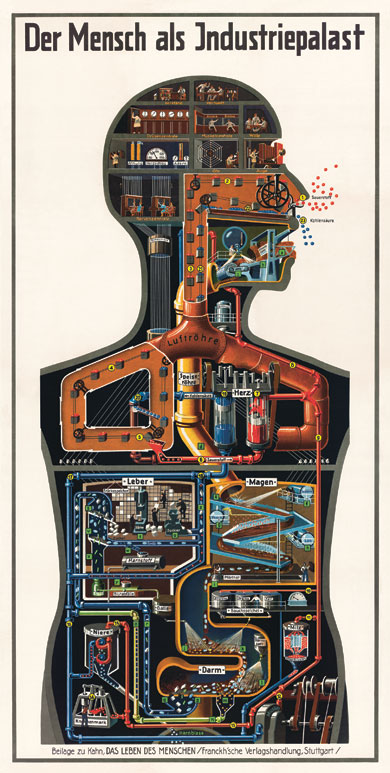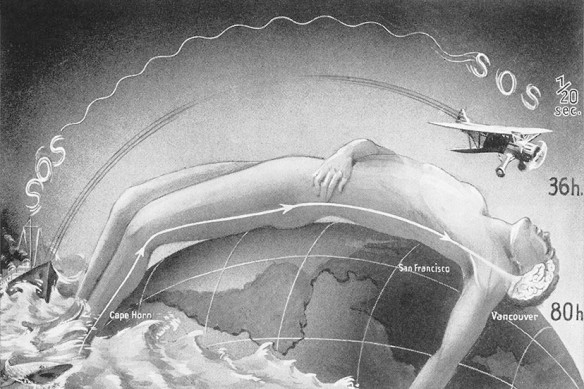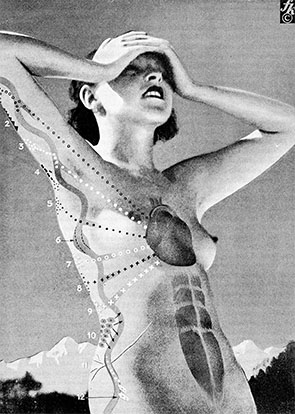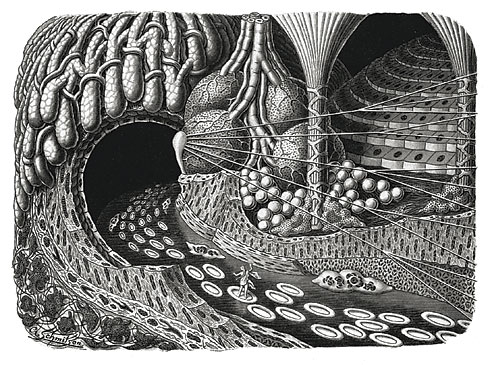
The 1926 illustration “Man as Industrial Palace” appears in the new monograph “Fritz Kahn – Man Machine.” Originally it appeared in Kahn’s “Life of Man, Vol. III.”
These visualizations of the human body as a modernist “industrial palace” by Fritz Kahn were meant to be instructive, developed to educate the public about human health in the 1920’s.
Industrial and technological imagery are juxtaposed with organic, sometimes even sensuous forms in which the complex structure of the human body is rendered into cold, lifeless machinery. Kahn’s illustrations reflect a world that was rapidly shifting to a “new nature” in which people could now fly, voices could be heard and recorded, and work was made increasingly more efficient.

The speed of thought, 1943

The effect of sunlight, 1940
Das Leben des Menschen (The Life of Man) was an encyclopedic work of 1600 pages and 1200 illustrations depicting biology as industrial and mechanical processes, adopting avant-garde visual techniques and contemporary styles such as Neue Sachlichkeit, Dada, Surrealism, and Constructivist photomontage.
Ever-concerned with de-mystifying the miracle of life with easily comprehensible words and pictures, Kahn wrote “The cell state is a republic under the hereditary hegemony of the mind’s aristocracy….its economic system is a strict communism.” Unsurprisingly, his books were placed on the Nazi “list of harmful and unwanted writings” and publicly burned. His medical license was revoked, and Kahn (a Jew) was forced to emigrate — first to Palestine, then Paris and eventually, with help from Albert Einstein, the United States.

“Fairytale journey along the bloodstream – Entering a glandular cavity with an idealized cell-scape,” illustration by Arthur Schmitson for Kahn’s “Life of Man, Vol. II,” 1924

Fritz Kahn, Man in Structure in Function (Fig. 208), 1943
Here, the reach of an arm longing for a final touch while saying goodbye is shown as an extension of a mechanical body composed of nothing more than discrete parts and electrical impulses. The accompanying text explains the functional analogy:
“Man and machine exhibit farreaching similarities. Both derive their energy from the combustion of carbon, which they obtain from plants. Man, the weaker machine, utilizes fresh plants for fuel, while the locomotive, a stronger machine, uses fossilized plants in the form of coal.”

Raoul Hausmann, Dada (Collage for the First International Dada Fair in Berlin), 1920
Kahn drew on previous and contemporary analogies between functional anatomy and technology as well as themes of modernity present in contemporary art (such as Raoul Hausmann’s Dada collage, above.) The mechanized battles of the First World War (and the widespread use of protheses thereafter) had helped to produce a man-machine analogue that made Kahn’s illustrations possible.
Forgotten for many years after being exiled by the Third Reich, Fritz Kahn’s work is now being rediscovered by historians, artists, and designers.
The intertwining of science, art and technology: An animated and interactive installation based on the poster of the same title by Fritz Kahn from 1927.












































 ‘bauen wohnen streifen #4’ from the hamburg series
‘bauen wohnen streifen #4’ from the hamburg series


